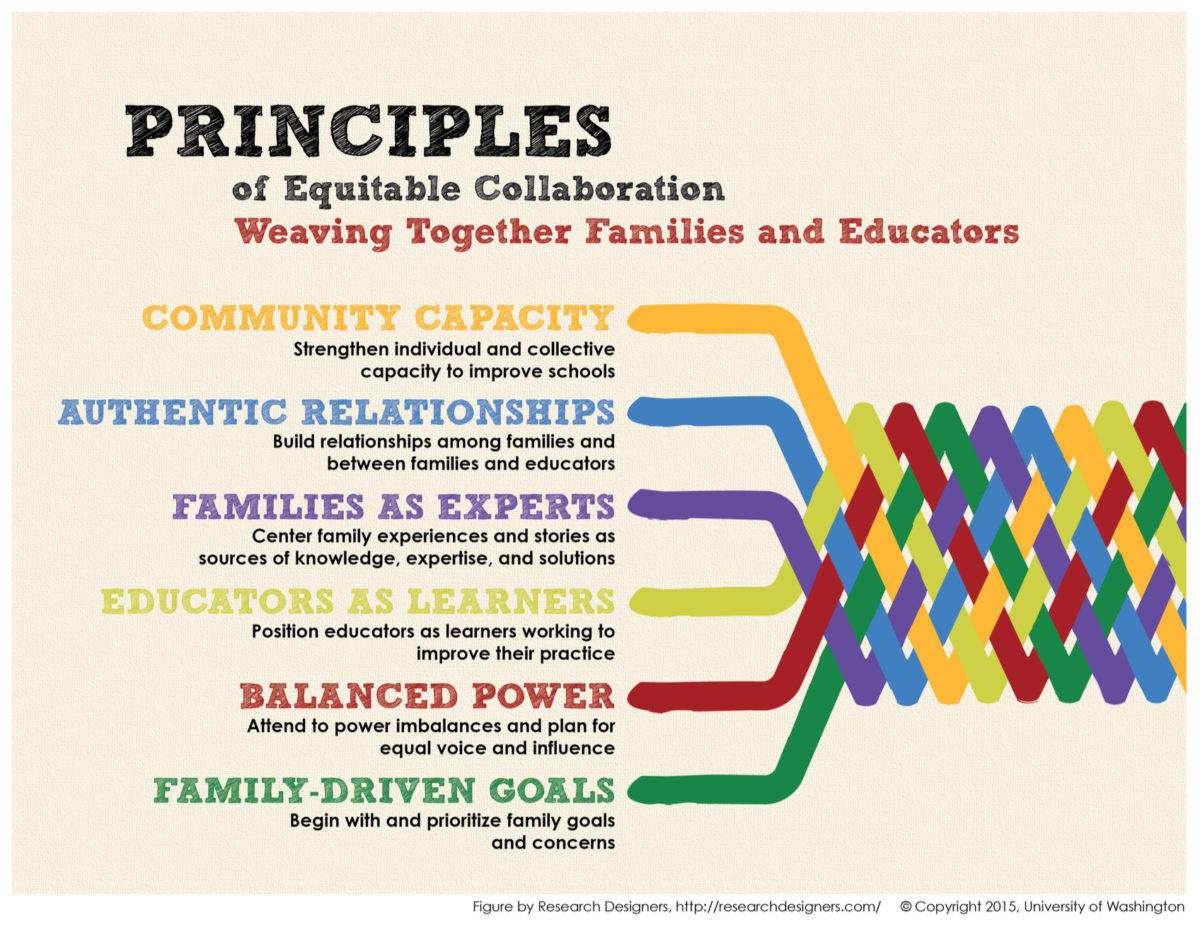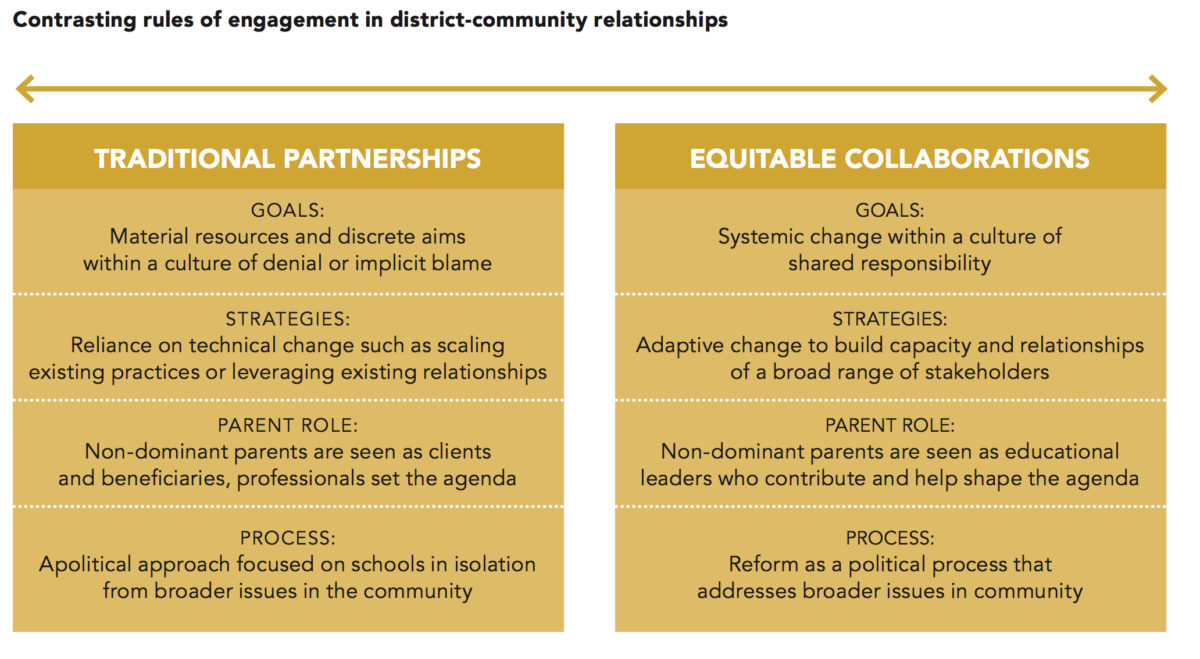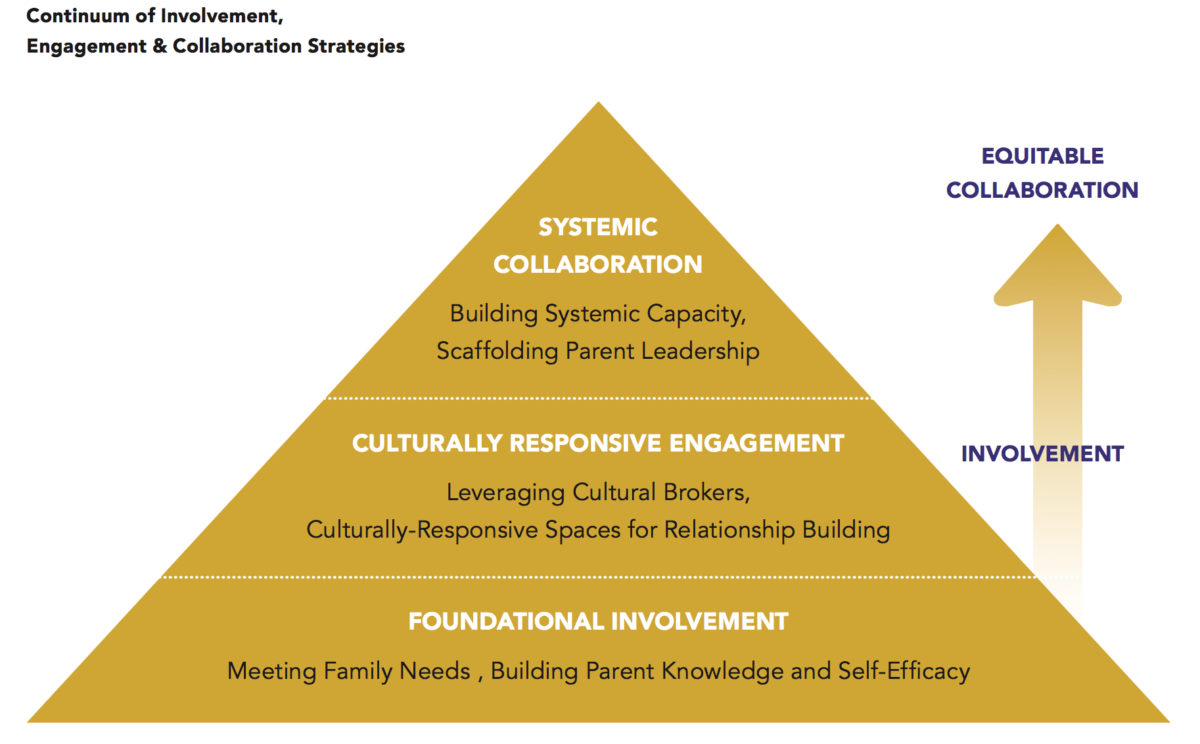The Equitable Collaboration Framework was developed by the Equitable Parent-School Collaboration Research Project at the University of Washington’s College of Education. The project’s research team seeks to understand and support parent-engagement programs that promote equitable educational outcomes for underserved students, families, and communities.
The Equitable Parent-School Collaboration Research Project’s research program currently focuses on the Road Map Project, a regional initiative in Washington state working to dramatically improve student achievement from cradle to college and career. During the 2012–2013 school year, the Road Map region served a diverse population of more than 120,000 students, of which 59% came from low-income households, 67% were students of color, and 16% were English-language learners.
“We stand at a critical moment for understanding the potential of family engagement for addressing persistent educational inequities in our schools and communities. Decades of research suggest parent-family-school relations are pivotal to student success. Especially for non-dominant communities, however, traditional parent involvement approaches—such as parent-teacher associations, open houses, and parent-teacher conferences—rarely realize this promise. New ‘collective impact’ efforts have arisen to eliminate educational disparities from ‘cradle to career’ through multi-sector collaboration. These initiatives bring together schools, community-based organizations, advocates, businesses, governmental agencies, and the public at large to improve the educational outcomes of students throughout a community. Within this context, family engagement represents a potentially powerful lever for change.”
Charting a Course to Equitable Collaboration: Learning from Parent Engagement Initiatives in the Road Map Project, Ann Ishimaru and Joe Lott
The Equitable Collaboration Framework
The Equitable Collaboration Framework encompasses several resources and publications that describe a variety of approaches to equitable collaboration with students, families, and community members. The following sections provide a brief introduction to a few of the models and recommendations produced by the Equitable Parent-School Collaboration Research Project.

Contrasting Rules of Engagement
The work of the Equitable Parent-School Collaboration Research Project utilizes a conceptual framework originally articulated by Ann Ishimaru in a 2014 article. The Equitable Collaborations Framework describes two contrasting approaches to family and community engagement in education—traditional partnerships and equitable collaborations—across four foundational dimensions of educational engagement: Goals, Strategies, Parent Roles, and Processes. The framework draws on previous studies of community organizing and civic capacity-building, or what the scholar Clarence Stone calls “the mobilization of varied stakeholders in support of a communitywide cause.”

In Charting a Course to Equitable Collaboration: Learning from Parent Engagement Initiatives in the Road Map Project, Ann Ishimaru and Joe Lott describe two essential elements of equitable organizing and capacity-building that are useful for understanding the Equitable Collaborations Framework:
1. Understanding
“Understanding highlights the need for collective vision and goals, as well as a sense of shared responsibility that moves beyond blame. Strategies that build capacity and relationships are key to this understanding and ability to act. To cultivate understanding, efforts must build individual capacity and understanding of the work as well as relationships between individuals, both those from similar backgrounds (for example, immigrant parents) and those from different backgrounds (for instance, parents and educators). Finally, at the level of organizations, sustainable reform requires changing relationships and interactions to create the political context needed to institute and sustain new practices.”
2. Participation
“Participation—or contribution to the cause—focuses attention on the role of stakeholders in the common effort, the resources they bring, and the need for cooperation between them. In conventional approaches, non-dominant parents are often relegated to the role of client or beneficiary. Educators or professionals act as “experts” who know what is best for them, and interactions are typically infused with highly unequal power dynamics. But as experts on their own children’s native language, culture, community context, and learning needs, low-income parents of color can play key decision-making, design, and implementation roles in education reform efforts.”
Four Dimensions
The four dimensions of the Equitable Collaborations Framework:
1. Systemic change that occurs within a culture of shared responsibility
Equitable collaboration requires educators, families, and community members to share responsibility for eliminating inequities in districts and schools. Traditional approaches to family engagement often focus on discrete goals—such a resolving a specific conflict between a teacher and parent, or fixing a problem with a single school program—rather than on systems-wide changes that will strengthen relationships between all teachers and families in a school, for example, or that will improve educational outcomes for students throughout a district. In school and community cultures characterized by “denial and implicit blame,” educators, families, and community members may deny their personal role in creating or perpetuating inequities, shift blame onto others, or believe that inequities are the result of causes beyond their control.
2. Adaptive change that builds capacity and relationships among a broad range of stakeholders
Equitable collaboration requires adaptive approaches to addressing educational inequities throughout a school system, not just tweaks and technical changes to existing policies, programs, and practices. In traditional school-community partnerships, for example, administrators may make hurried, unilateral decisions based on assumptions about student or family needs, rather than listen to the community express its needs and concerns, and then develop more informed and responsive programs in collaboration with students and families—as they would in a culture of equitable collaboration. Educators may also seek out partnerships with community leaders or organizations they are socially connected to or comfortable working with, for example, instead of actively and intentionally reaching out to local cultural groups they don’t already partner with, but that may be more representative of the students and families the school serves.
3. Non-dominant parents are seen as educational leaders who contribute to and help shape the agenda
Equitable collaboration requires school leaders and educators to see families as experts who possess valuable knowledge about their children, community, or culture—especially parents and family members from groups that were historically marginalized by the education system. In traditional partnerships, educators may overvalue educational or technical expertise, such as an understanding of state education policy or effective methods of instruction, for example, while undervaluing other forms of expertise, such as a mother’s understanding of her child’s social-emotional needs or a nonprofit’s knowledge of a particular racial, ethnic, or cultural community. Equitable collaboration also requires school leaders and educators to share power or decision-making with youth or families, particularly during the early stages of a process when questions are being framed, problems are being discussed and agendas are being determined.
4. Reform is a political process that addresses broader issues in community
Equitable collaboration requires participants to acknowledge and understand that schools are situated in complex, interdependent communities, and that both school systems and communities are shaped by larger historical, socioeconomic, political, and cultural forces. For example, some families—such as those from dominant cultural groups and more privileged backgrounds—are typically better positioned to influence school policies or advocate for their children, while others—such as those from historically marginalized cultural groups and less wealthy or educated backgrounds—may not have the same level of knowledge, confidence, or social connections, which can undermine their agency and influence on the school system. In this context, equitable collaboration may require capacity-building strategies—such as training in community organizing, for example—that will help youth and families from non-dominant cultural groups identify and understand systemic inequities and how they can mobilize to demand changes in school policy or practice.
Continuum of Involvement, Engagement, and Collaboration Strategies
Another useful framework described in Charting a Course to Equitable Collaboration is the Continuum of Involvement, Engagement, and Collaboration Strategies, which is based on case-study findings from the Road Map Project and on previous research on effective family-engagement models. The continuum is represented as a pyramid to “suggest both the number of parents who may be engaged with those strategies at any given moment as well as the progressive nature of the journey from involvement to equitable collaboration.”

1. Foundational Involvement
Foundational involvement strategies can reach a larger percentage of students and families in a school system, and they can provide a variety of benefits and essential services, but foundational involvement strategies are less like to build the knowledge, skills, and confidence of students and families or result in policies, programs, and practices that promote equity throughout a school system. Ann Ishimaru and Joe Lott describe two representative approaches to foundational family involvement:
- Meeting family needs refers to programs that have a “holistic focus on helping families to address their basic economic, health, and other needs as a means of enabling them to better support their children’s learning and academic success.” This approach to family involvement may provide essential or urgently needed interventions and services—such as food, healthcare, childcare, counseling, or housing assistance, for example—but it typically focuses on short-term, case-by-case solutions to problems that are ultimately driven by systemic causes such as poverty, opportunity gaps, institutionalized racism, or political disenfranchisement.
- Building parent knowledge and self-efficacy refers to orientation programs and learning opportunities that provide families with “information about how schools work,” such as the school’s “expectations for students, identifying whom to talk with to address questions or resolve issues, and academic concepts such as grades, test scores, and standards.” This approach to involvement may increase family understanding of school policies, help students make more informed educational choices, or increase a parent’s ability to support their child’s education at home, for example, but it typically focuses on educating families about the existing system, rather than changing the system to better serve families. As the authors write, “Conventional parent-education efforts often focus on giving parents information without a concurrent focus on receiving feedback and information from them to improve educational systems.”
2. Culturally Responsive Engagement
Culturally responsive engagement strategies not only help to create “a context within which parents and families feel welcome and part of the school community,” but they also “acknowledge and affirm the diverse cultural and linguistic backgrounds of families as a source of strength rather than as a barrier to student success.” The authors describe two representative approaches to culturally responsive engagement:
- Leveraging cultural brokers refers to schools working in collaboration with teachers, staff, youth leaders, parents, or community members who “represent the many cultural communities” served by the school and who “have a foot in two worlds: the world of the school/formal organizations and the world of a specific cultural community.” Cultural brokers can “help families from non-dominant cultural communities to understand and access information, resources, and opportunities from the dominant institutions,” while also helping institutions “address, understand, and change community needs and priorities.”
- Creating culturally responsive spaces for relationship-building refers to policies, programs, and practices that promote cross-cultural awareness, sensitivity, and understanding both inside and outside of the school and classroom. Examples of culturally responsive spaces might include courses that are taught in multiple languages or that feature multiple cultural perspectives, youth-organizing groups that build build multicultural coalitions of students and adult allies, restorative-justice circles that create opportunities for cross-cultural understanding and conflict resolution, or home-visit programs that facilitate relationship-building interactions between teachers and parents outside of the school.
3. Systemic Collaboration
Systemic collaboration strategies “seek to change the structures, systems, policies, and practices in educational systems that systematically exclude or marginalize families and students, particularly when they do not reflect the dominant class, culture, and language.” The authors describe two representative approaches to systemic collaboration:
- Building systemic capacity refers to schools and community partners supporting strategies that develop the knowledge, skills, and mindsets—of school leaders, educators, students, families, and community partners—that are required to identify, challenge, and redress entrenched inequities in educational systems. Systemic capacity-building can take a variety of forms, including school-community partnerships that help to remove barriers (e.g., limited access to transportation, a lack of childcare, or language differences) to family engagement; training and skill-building programs that address issues such as diversity, cultural sensitivity, or trauma-informed instruction; academic courses and adult-learning opportunities that educate students and families about race, class, power, and privilege in society; or inclusive planning and organizing processes that involve educators, staff, students, families, and community members in the co-development of more equitable school policies and programs.
- Scaffolding parent leadership development refers to programs and practices that progressively develop parent leadership skills and provide ongoing support to emerging parent leaders. Examples of scaffolding leadership development could include parent groups self-organizing to advocate more equitable district policies, “parent universities” that provide instruction and training in advocacy or civic leadership to parents; or diversity recruitment and hiring initiatives help parents become volunteers, family liaisons, or educators in the school system. The authors discuss an example of a program that supported families “take on “stretch” assignments with increasing responsibility and influence. ‘Stretch’ assignments are tasks or roles that require knowledge or skills beyond individuals’ current capacity in order to enable them to grow and learn.” Over the course of 12 months in one district, “community leaders became recruiters, translators, workshop facilitators, trainers, curriculum developers, and even teachers within their communities.”
Recommendations for Cultivating Equitable Collaboration
The case studies in this research suggest promising strategies for strengthening family engagement work within a collective impact context. Equitable collaborations between families, schools, and communities are not, however, built overnight. The findings from this study suggest that such work entails long-term investments, new relationships, and capacity-building of not only parents, but also educators and staff who work with culturally and linguistically diverse communities. We first provide a set of general recommendations and then address recommendations tailored to districts, schools, and collective impact initiatives.
1. Create a reciprocal, collective and equitable vision of family engagement tied to improving educational systems.
Individualistic, deficit approaches to “training” parents are often strongly embedded in the culture and norms of schools and other organizations. Thus, explicit conversations among school/district leaders, educators, families, and communities about the collective goals and outcomes of family engagement work must move beyond conventional assumptions and practices. When all stakeholders have a meaningful role in shaping this vision, they can become co-creators of equitable family engagement practices and, as a result, more responsive schools and institutions.
2. Recognize and address inequities in power between districts and community-based organizations.
Community-based organizations (CBOs) can be powerful allies and resources for schools and districts, but the highly unequal power dynamics between CBOs and districts can threaten their ability to collaborate productively and to realize the promise of collective impact. Although the rhetoric of partnerships is everywhere, districts often set the agenda and terms of engagement, relegating CBOs to passive support roles. Because of their greater power, it is incumbent on districts and policymakers to take the first steps to open the lines of communication and provide access to the resources (not only financial resources but also time and space) and decision-making processes that most directly affect the families served by CBOs. Schools can commit to connecting families with CBOs, sharing data, providing space, communicating regularly, and jointly planning school engagement and improvement efforts.
3. Recognize and address inequities in power between policymakers, professional educators and parents/families.
The profound power differentials between policymakers, professional educators and parents/families both within districts and in the broader regional context can stifle the meaningful participation of parents and families and limit their contributions to improving the opportunities to learn for young people. Both research and practice have demonstrated parents’ capacity to engage in core discussions and critical decision-making about the issues that concern them most; professionals and educators who presume parents should not be present or part of policy or organizational decision-making are underutilizing the intellectual and social resources of their communities. Rather than feeling they are losing power or control, professionals and educators can proactively seek out the expertise of parents and families to gain new ideas and additional capacity. Districts and other institutions may need to challenge policies that reinforce power inequities, such as formal education requirements for leadership roles, English-only discussions, or meeting times that create barriers for participation. And organizational leaders must play a key initiating and supporting role in creating the conditions that promote equitable relationships.
4. Create and sustain a culture of professional learning in family engagement practice.
Like good teaching, equitable family engagement work is complex, context-specific, and requires constant reflection, collaboration, and efforts to improve. Organizational leaders (in both districts and CBOs) should approach family engagement work as a professional practice that entails ongoing reflection, learning, and efforts to innovate as part of a broader culture of learning throughout the organization. Organizations should model and support the collection and use of broad forms of data (including student and family voices) to assess progress and guide improvement.
5. Provide multiple opportunities for engagement that foster parent-to-parent networks and leadership.
A range of engagement opportunities enables parents and families to engage in ways that are meaningful and culturally appropriate for them and their children while also growing their capacity and participation over time. While such opportunities may start with workshops and services to meet family needs, promoting parent-to-parent networks and cultivating leadership opportunities can strengthen how schools leverage the knowledge, skills, networks and other assets that parents/families can bring to improve schools and communities. Designated physical space in schools and time for families to meet and build relationships can facilitate these networks. Leadership opportunities can include both formal and informal roles, facilitation, and mentoring for other parents, and participation in community, district, and school-level committees. Family participation across these roles should reflect the student populations in the community.

DISTRICTS
1. Prioritize family engagement work as a strategic, shared responsibility
Superintendents play a pivotal role in communicating the strategic priorities and expectations of family engagement work as a shared responsibility that is central to the core work of educating students, rather than the marginalized domain of a few designated staff members. The inclusion of family engagement as a key component of a district’s strategic work can signal its importance and highlight roles in the work for every educator, from the superintendent and school board to classroom teachers and support staff. Moreover, dedicated resources—both full-time staff and financial resources for programs—comprise critical foundational infrastructure for sustained family engagement work in schools and across a district.
2. Invest in building educator capacity
Teachers and other educators (including instructional assistants and specialists) are often the first point of contact for families, but they often also feel under-prepared and have weak supports for building reciprocal, learning-focused relationships with families in linguistically and culturally diverse communities. School-centric cultures, a fear of parent voices and power, and limited understanding of issues of race, culture, class, and power can further limit educators’ ability to engage productively with parents and families, particularly around issues of teaching and learning. Educational leaders can provide professional development, modeling, and ongoing resources and supports to build teachers’ capacity to collaborate with families, particularly through models which rst position educators as learners (such as home visits, neighborhood walks, or equity work).
SCHOOLS
1. Cultivate a welcoming learning environment for families and community
As school leaders, principals play a key role by modeling responsiveness to families and opening new opportunities for collaborating with them. This requires more than an “open door” policy or the inclusion of families as an afterthought. Empowering school leadership practices can build capacity and lead to sharing leadership, planning, and decision-making with parents, teachers, other educators, support staff, and community members. Such practices should strive to create “community-ready” schools in which educators see themselves as part of the neighborhood and parents and families perceive the school as a hub for the entire community.
2. Identify and leverage cultural brokers to foster culturally responsive relationships between parents/families, teachers, and other educators
In building trust and highly reciprocal relationships between families and educators—especially when language and cultural differences are present—“cultural brokers” play a key role. These individuals are familiar with the cultures of schools and often already informal leaders in their own cultural communities. Cultural brokers can be district staff, but they should not be restricted to employees. These connectors introduce families to the school culture, build their capacity to advocate for their own and community needs, introduce educators to the cultures of their students and families, and facilitate ongoing, two-way communication between families and schools. Schools need to be culturally responsive to the racial/cultural communities of their students and families, even if they are groups who speak English well, such as African Americans, American Indians and Pacific Islanders.
COLLECTIVE-IMPACT INITIATIVES
1. Establish a regional policy for equitable parent/family engagement.
Collective impact initiatives are uniquely situated to prioritize the work that promotes equitable family- school-community collaboration. [Hub organizations] can convene districts, CBOs, families and other stakeholders to envision and develop policies and strategic efforts around equitable family engagement across the region. The initiative can also identify resources and facilitate capacity-building to implement such a policy with multiple actors at multiple levels of the educational system.
2. Foster cross-organizational learning and capacity-building around equitable practice in family engagement.
Collective impact hub organizations…can play a critical role in building organizational capacity and cross-effort learning to improve family engagement practices. Creating meaningful opportunities for the voices and expertise of parents and families themselves to impact regional priorities and efforts can provide a powerful model for participating organizations. Moreover, Road Map organizations are eager to gain access to indicators, tools, professional development and other supports for improving their work and their approach to collaborating with families in new and more reciprocal ways.
3. Create systems, policies, and practices of equitable collaboration between organizations within the initiative.
In an equitable collaboration, all the participating organizations feel they have an equal voice and that their knowledge and contributions are valued and legitimate contributions to the shared goals of the effort. Policies and practices that reinforce individualistic competition between organizations for resources, legitimacy, support, or attention can undermine the sustainability and political will of individuals and organizations to sustain the collective effort. One manifestation of this is the equitable allocation of funding and access to funding opportunities between organizations of varied sizes and capacities. Funders can also play a critical role by supporting collective grants that allow collaborating partners to fund aspects of each partners’ budget that is allocated to the parent engagement effort.
Acknowledgments
Organizing Engagement thanks Ann Ishimaru for her contributions to improving this introduction, and the Equitable Parent-School Collaboration Research Project for permission to republish excerpts and images from its website and publications.
Creative Commons

This work by Organizing Engagement is licensed under a Creative Commons Attribution-NonCommercial-ShareAlike 4.0 International License. When excerpting, adapting, or republishing content from this resource, users should cite the source texts and confirm that all quotations and excerpts are accurately presented.
